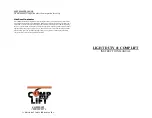
Anthony Lifgtates, Inc.
40
MRT Models
www.anthonyliftgates.com
800-482-0003
7.1.1 Monthly Inspection
Preventive maintenance should be performed on a
monthly schedule or any time the unit shows signs of
improper/abnormal operation or abuse. Following these
steps helps to ensure maximum operator safety and your
overall performance satisfaction.
This inspection procedure starts at the front of the truck
and works its way back to the liftgate. Make sure the
vehicle is securely braked before performing any of the
following steps.
1. Check the truck’s battery.
Make sure the cells of the battery are properly fi lled.
Check the battery for cracks, leaks, or other obvious
damage.
Make sure the battery hold-down clamp is securely
tightened.
Make sure the liftgate power cable connection is
tight.
Remove any corrosion, dirt, or grease from the
battery terminals and/or wire connections.
Periodically replace the old battery. (Do not let the
battery fail and then replace it.)
2. Check the circuit breakers to make sure the
connections are tight. One circuit breaker is located
in the truck’s battery box and the other is in the
liftgate’s battery box. Check the power cut-off switch
to make sure it disables the power to the power unit
when it is turned to the off position.
3. Check the power cable from the truck battery back to
the liftgate power unit.
Make sure all connections are free of dirt and
corrosion.
Make sure all connections are tight.
Make sure the entire length of the power cable is
not cut or damaged.
4. Inspect the power pack enclosure and battery box for
damage.
Remove any buildup of dirt or debris.
Make sure all the rubber grommets are installed in
the access holes through the side of the box. This
prevents damage to wires and hoses from rubbing
against the metal surface of the enclosure.
5. Inspect the batteries in the battery box enclosure
using the inspection checks in Step 1.
6. Check the electrical and hydraulic connections inside
the power pack enclosure and the battery box.
Check all control wires for corrosion and make
sure they have tight connections. When replacing
connectors use only Heat Shrink Terminals.
Check the electrical connections to the starter
solenoids.
Check all hydraulic hoses and fi ttings for fl uid leaks.
Tighten the fi ttings to stop leaks or replace them if
they are damaged.
Check the condition of the hydraulic hoses.
Replace them if they show signs of leakage or
excessive abrasion of the covering.
7. Check the fluid level in the power unit hydraulic tank.
Fill the tank as required with Dexron VI, Dexron III
ATF hydraulic oil or Hyken Glacial Blue. For cold
weather operation, we recommend Hyken Glacial
Blue. Do not use brake fluid.
Fill to within 1/2” of full with the platform on the
ground.
Fill power down models to within 1/2” of full with
platform raised.
8. Inspect the hoses and control wires coming from
power unit to the liftgate.
Check for signs of leaks or chaffi ng on the outside
covering of the hoses and wiring.
Make sure the wires are securely fastened to the
truck body and not hanging loose where they could
be damaged.
Remove any build-up of dirt and debris from the
hoses and wires.
9. Make sure the liftgate is operating properly through
the complete opening and closing cycle. Before
operating the liftgate, make sure the area is free of all
obstacles, obstructions, or people. Also, if the liftgate
is equipped with a power cut-off switch, turn the
switch to On.
Check for any clearly visible damage that would
prevent the liftgate from operating properly.
Check the control switches for corrosion, dirt build-
up, or damage.
Check for unusual noises or vibration as the liftgate
operates.













































